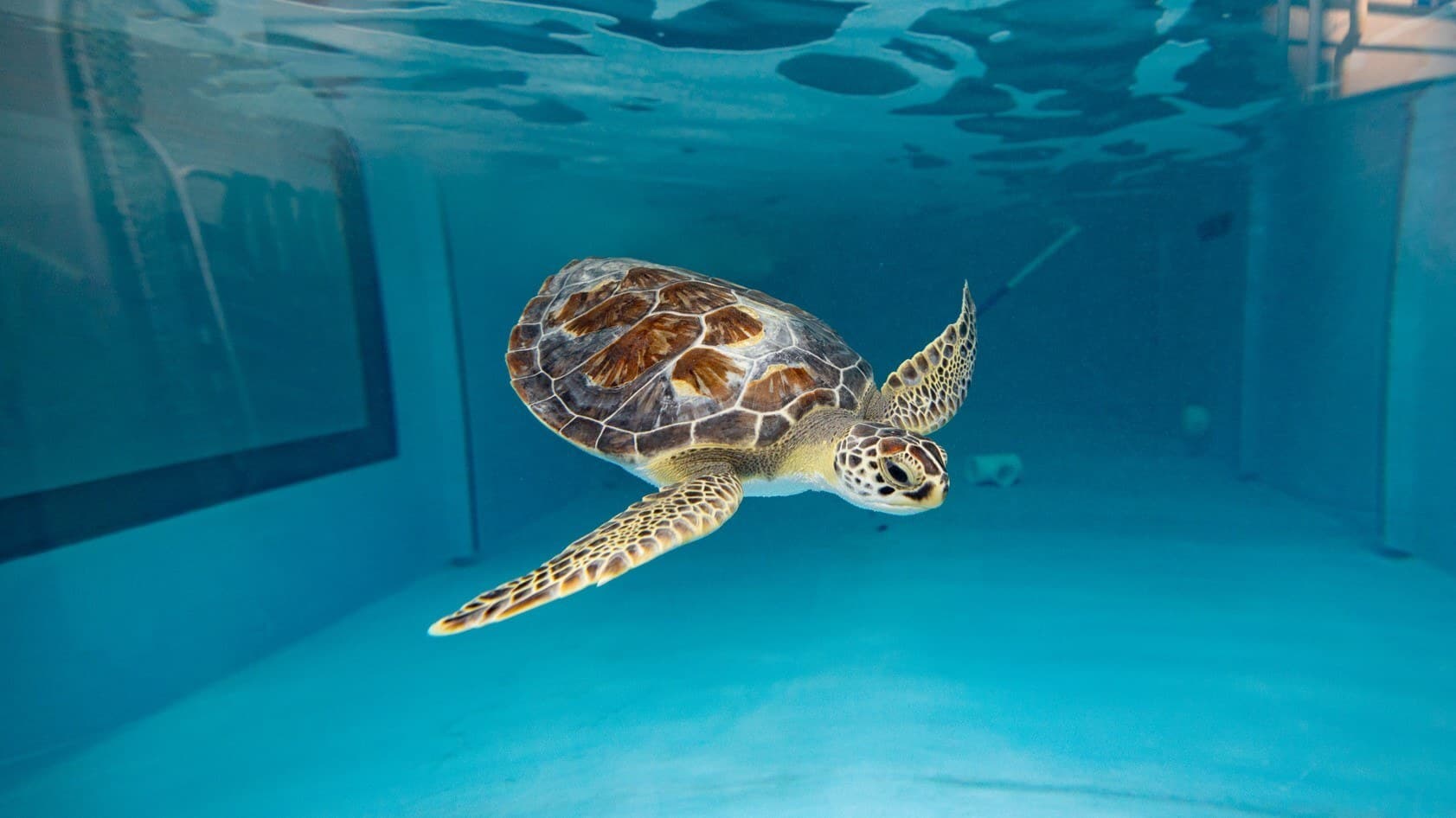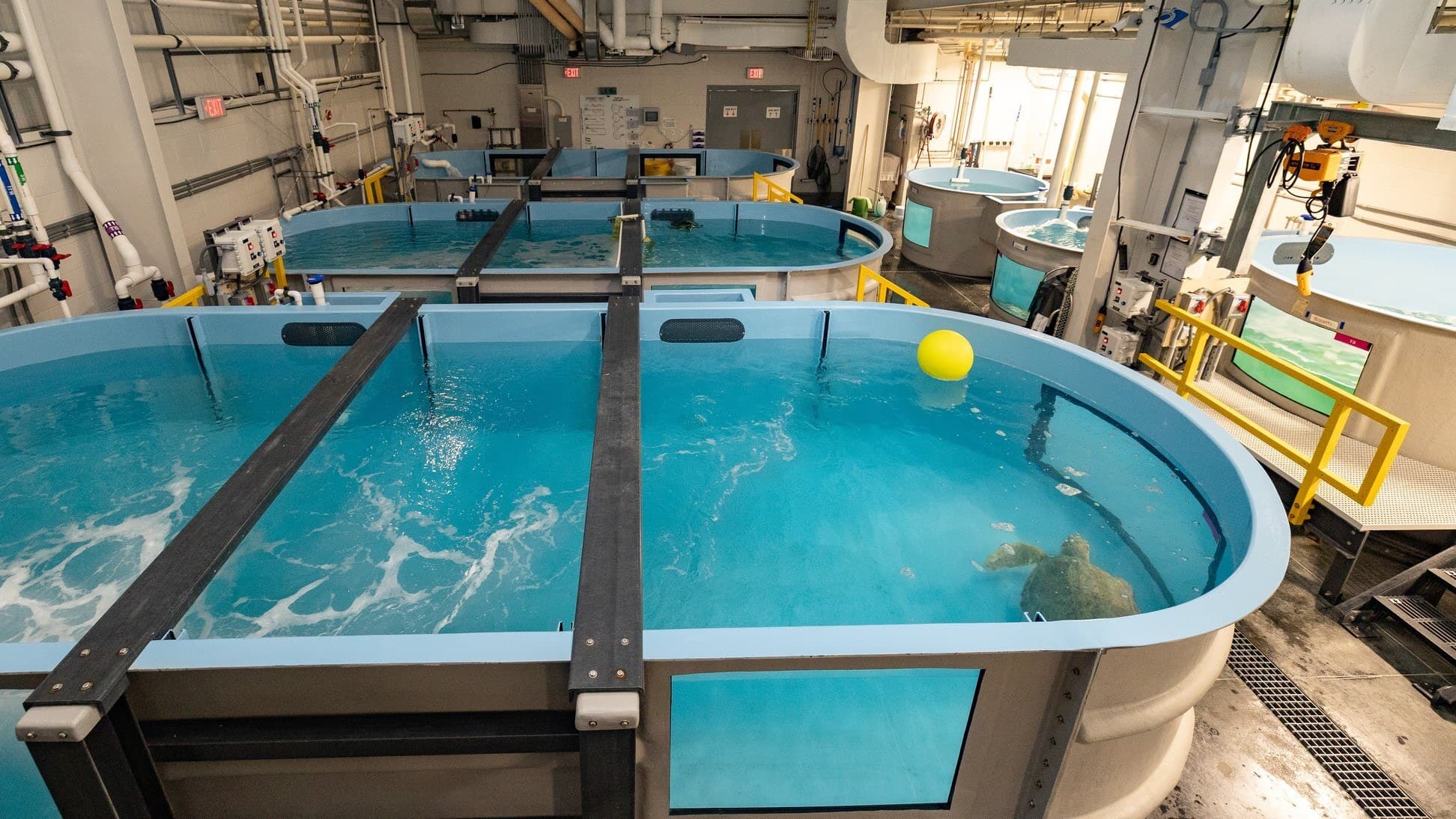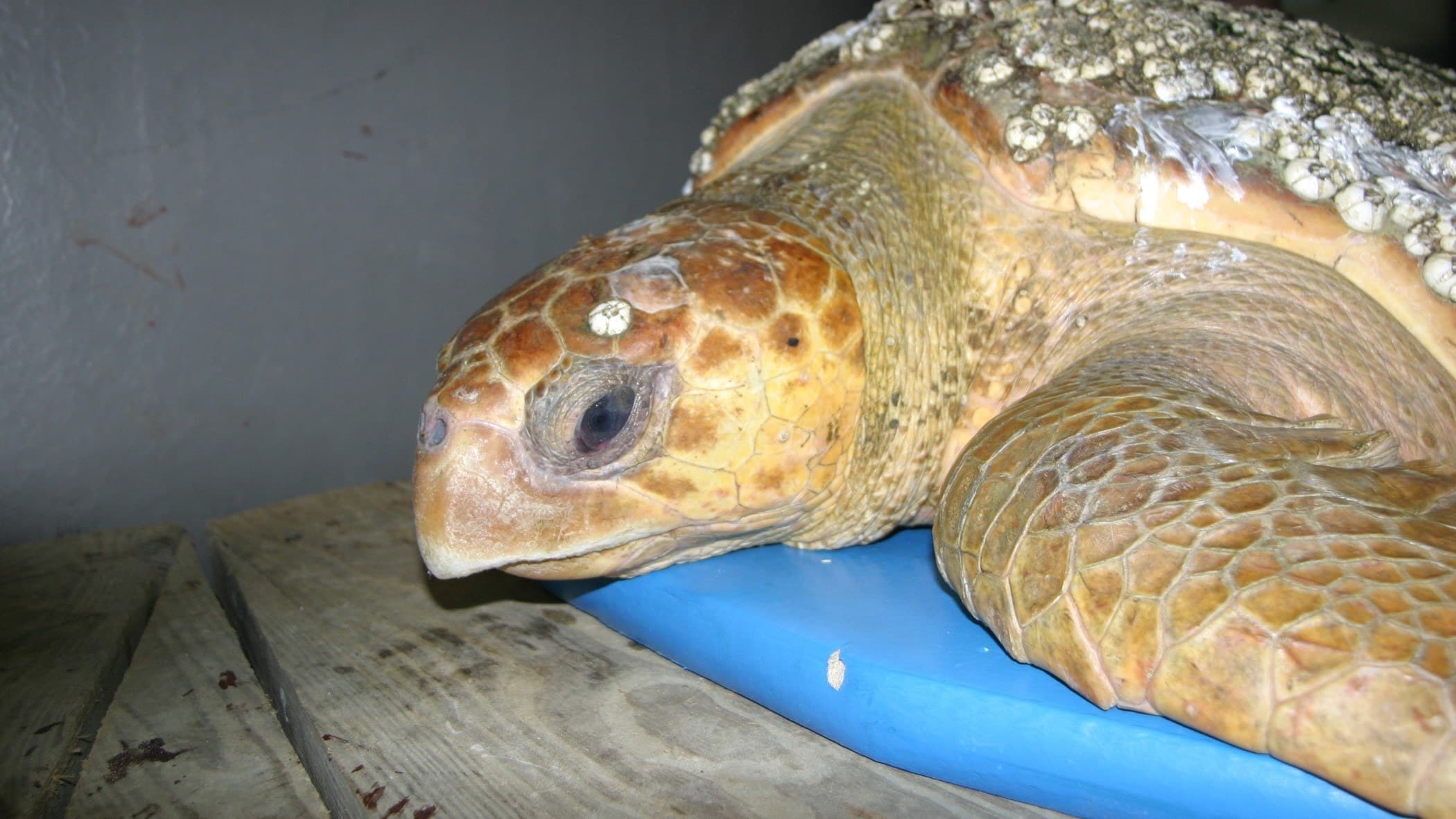Our Stranding Response Team worked hard this past summer responding to hooked and otherwise stranded sea turtles all along Coastal Virginia, and our Stranding Response facility admitted numerous turtle patients for rehabilitation through this summer’s hooked-turtle season. But rehabilitation isn’t an easy task, and a tremendous amount of work is required to rehab a sea turtle for release back into the ocean.
“We receive around 200-300 sea turtle strandings per year and around 150 marine mammals per year,” said Chelsea Witherup, a full-time staff member with the Stranding Response Program. “The majority of our strandings are deceased animals” who died prior to being found by humans, “[but annually] we typically have between 60-100 sea turtle rehab patients.”
Our Stranding Response team is operated by staff like Chelsea as well as a slew of committed volunteers, all of whom have dedicated years of efforts to helping sea turtles recover from illness or injury and releasing them back into the ocean. The brunt of the husbandry (feeding, cleaning, etc.) is conducted by Stranding Response volunteers, who are critical to operations and whose work allows staff members to focus on coordinating the logistics of responding to a stranded animal, as well as the clinical side of rehabilitation.
Though there are numerous circumstances in which sea turtles become stranded, the majority of rehabilitation cases in our area are typically caused by one of two reasons. Either they have been hooked on a recreational angler’s line - which happens primarily during the spring & summer - or, as winter approaches, they become cold stunned when the water temperatures drop, sometimes quickly, as sea turtles rely on their environment to maintain their body heat. For this reason, our Stranding Response team refers to the warm part of the year as hooked sea turtle season, while the colder months are cold-stun season.
When Stranding Response responds to a stranded sea turtle, they’ll assess for signs of illness or injury – if the animal appears sick or wounded, they’ll run diagnostics and administer medications. Most, if not all, live stranded turtles are deemed candidates for rehab, so will be placed in either a tote box if the turtle is small, or a dog kennel if the turtle is large enough to require it. The team pads the box or kennel with towels, then loads the turtle into their van to transport it to Virginia Beach from wherever it was found along the over 7,200 miles of coastline in Virginia.
Our Stranding Response team operates out of the Darden Marine Animal Conservation Center (DMACC), a newer facility that opened in 2021 after the team spent years working out of a smaller, rented building. The Center was named after the Darden Family and the Joshua P. and Elizabeth D. Darden Foundation, who made a generous contribution that helped bring the facility to life. The DMACC is equipped with a sea turtle hospital area, animal quarantine center, separate necropsy building, in-house pharmacy, offices, and meeting spaces.
Once the response team arrives back at the DMACC, one of the Aquarium’s veterinarians removes any hooks found in the turtle’s mouth or body. Other turtle patients that don’t need a hook removed are placed in one of the many triage containers or rehab pools where they undergo, per Chelsea, “a transition period of water types, starting with fresh water, which can help with hydration and kill off excess epibiota (barnacles, algae, etc.).” The team then slowly adjusts the water over time to increase salinity and match the turtle’s natural environment in the ocean. For cold-stunned turtles, the team must also increase the temperature of the water extremely slowly – usually only a few degrees Fahrenheit per day, as increasing the turtle’s body temperature too quickly can be detrimental to the animal’s health.
New turtle patients are given a profile in the team’s records system and given a name by staff – usually with a new naming theme every season, such as cereals or band names (this year’s naming theme for hooked turtles is landmarks and areas of Virginia Beach, in celebration of the City’s 60th Anniversary). New patients are also kept separated from others while they undergo medical evaluations and monitoring. If they are not carrying any communicable diseases or parasites, they may be moved into larger hospital pools and share water with other turtles. Though they’re sometimes separated from one another with barriers to facilitate feeding and administration of medications.
The number of sea turtles our Stranding Response team can rehabilitate at one time depends on the sizes of the patients. According to Chelsea, “We could have 20-30 small [Kemp’s] ridleys and green turtles in-house or less than 10 loggerheads. This is based on the different sizes/age classes of these species we see in our area. Kemp’s ridleys visit our local waterways roughly between 3-10 years of age. Kemps’ adult weights would be close to 70-100 pounds while adult loggerheads can get up to 350 pounds.”
The staff’s daily routine for the rehab hospital is much like a human hospital. They begin the day by walking through the facility, making sure all the turtles are swimming, and ensuring the treatment tanks and systems are operating properly. They’ll write up treatment schedules for the day, perform the treatments for the turtles as well as any routine or emergency diagnostics, feed the animals, communicate with the veterinary team who evaluates any new diagnostics, and compile daily reports on all patients. The veterinary team normally visits once a week but can be found making daily visits to remove hooks if there are a lot of hooked turtles!
Depending on the original cause of stranding, sea turtle rehabilitation can take anywhere from a couple of weeks to a few years to complete. Very rarely is there a patient that cannot make a complete recovery, but on occasion, some rehab animals cannot be approved for release. One of the team's longest-rehabbed animals was a sea turtle named Boise, who had been struck by a boat and was in their care for a few years. Per Chelsea, “Boise’s back flippers were paralzyed, and due to the low chance of survival in the ocean with this type of injury, it was deemed non-releasable and sent to another aquarium to become an ambassador,” living on exhibit so it can educate the aquarium’s guests on sea turtles and conservation.
Another sea turtle named Kale was a hooked patient in 2019, and the veterinarian performed an esophagostomy (surgery through the neck into the esophagus) to remove the fishhook due to how deep it was in the esophagus. But when Kale’s skin healed, they found that a hole developed between the esophagus and the outside of his body, which persisted even after multiple repairs to the damaged tissue and would have made it unable to survive in the ocean. As a result, the turtle was deemed non-releasable, and was sent to another aquarium to become an ambassador, educate the public on marine conservation, and live out its life in an enriching habitat with regular veterinary care.
(By the way: It’s not often possible to determine the sex of a sea turtle until it is sexually mature or without additional testing, and most of Stranding Response’s animals are admitted as juveniles!)
For most of Stranding Response’s rehab animals, “the goal is to release them back to the ocean,” Chelsea explains. “We’re looking for no signs of infection in their radiographs. We’re looking for ‘normal’ ranges of bloodwork. We’re looking for healed wounds and normal eating and swimming behaviors, and that really covers it!”
When an animal is cleared for release, they are given a Passive Integral Transponder, or PIT tag, much like the microchips used for pet dogs and cats. The PIT tag is utilized for tracking and research purposes. If an animal carrying a PIT tag were to strand again, the unique tag number can be submitted to the national sea turtle database to find the animal’s prior stranding history.
The team then has to decide where is best to release the sea turtle. In the summertime when our local waters are warm, we release sea turtles into the Atlantic Ocean from one of the local beaches. In the colder seasons, the team organizes transportation of the turtles, sometimes with other stranding partners along the East Coast, down south to the warmer waters such as Georgia or Florida. We are not currently hosting public releases, but beachgoers who happen to be nearby when we release turtles usually love to stop and snap a photo!
The Stranding Response Program is funded by the Virginia Aquarium Foundation and has responded to over 10,000 sea turtles and marine mammals since its inception in 1991. Our staff and volunteers thank our donors and supporters for your contributions to the Foundation to help us conserve sea turtle species and the marine environment!



